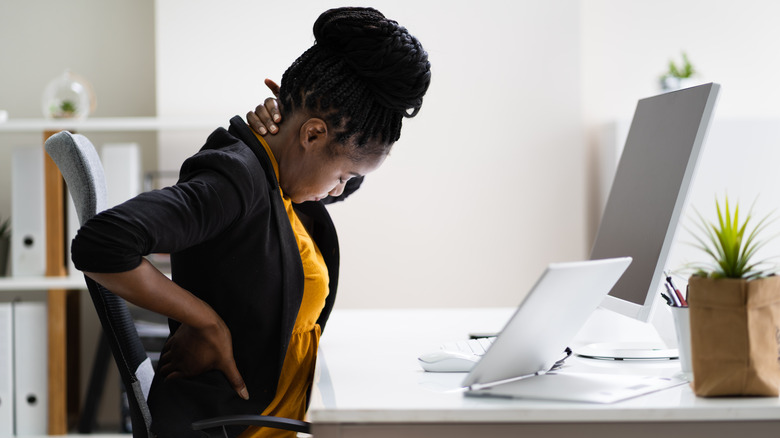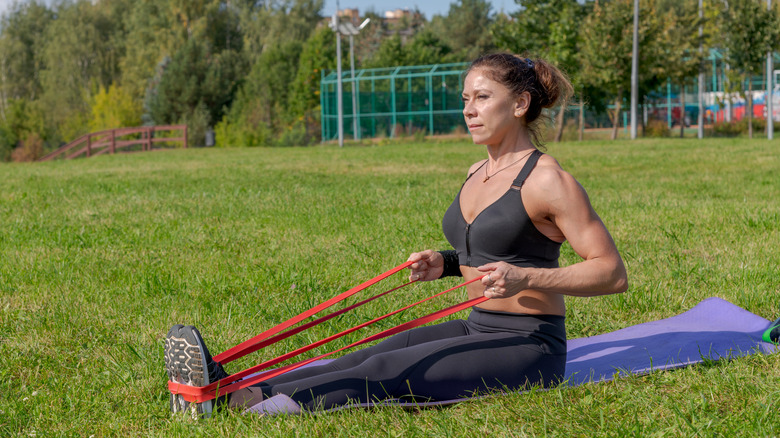Posture Workouts Could Be The Key To Working From Home Pain Free
Working from home may seem like a dream come true, but that's not always the case. For starters, it can be difficult to set work and home-life boundaries, especially if you don't have a designated office space. This practice also involves prolonged sitting, a common cause of body aches. "Most people are not used to working from home this much, and they may not have ergonomically correct chairs and desks, so we are getting more complaints of back and neck pain," said Dr. Daniel Riew, an orthopedic surgeon at NewYork-Presbyterian.
Clinical evidence supports these findings. For example, a 2018 study published in the International Journal of Health Sciences and Research found that more than 75% of people who sit at work have low back pain. On the other hand, only 73% of those with standing occupations experience this issue. Proper ergonomics may help prevent back pain to some extent, but you also need to keep your body moving. As Dr. Riew notes, a sedentary lifestyle can increase the risk of sciatica and other spine problems.
That being said, some exercises are more effective than others when it comes to back pain. Evan Johnson, a physical therapist at NewYork-Presbyterian, recommends exercises that build core strength and target the muscles around your spine. Posture workouts — which include simple movements like the cat-cow, rows, and plank variations — can stretch and strengthen your back muscles, alleviating the impact of prolonged sitting.
Stuart McGill's Big Three
Dr. Stuart McGill, a distinguished professor emeritus, recommends three simple exercises to strengthen your core and lower back. These include the bird-dog, curl-ups, and side bridges and should be performed daily. McGill's "Big Three" can improve your posture and stabilize the spine, which may help prevent or reduce back pain. For best results, complete three sets of each exercise, decreasing the number of reps from one set to the next. Use a slow, controlled motion, and hold the contraction at the top of the movement.
Consider starting with curl-ups. Lie on your back with one knee bent and place your hands underneath your lower back. Squeeze your core and lift your shoulder, flexing the upper back. If you do it right, you should feel your abs working. Maintain the contraction for 10 seconds or so, relax, and repeat.
To do a side bridge, get on your side with both knees bent and your elbow underneath your shoulder. Contract your abs and glutes while lifting your hips. Make sure your body forms a straight line. Hold for 10 seconds, bring your hips back down, and start all over. Fianlly, get on all fours to perform the bird-dog. From this position, lift your right arm and left leg while bracing your core. Hold the contraction for 10 seconds, return to the starting position, and repeat with the opposite arm and leg. Add dumbbells, ankle weights, or resistance bands to the mix for a more challenging workout.
Plank variations
From increased core strength to back pain relief, there are plenty of reasons to start planking every day. The side bridge is actually a plank variation, but you can also try the reverse plank, knee planks, rocking planks, or single-arm planks, depending on your fitness level. For example, plank rollouts will challenge your balance, making your abs work harder. This exercise requires a fitness ball, foam roller, or ab wheel, and can be adapted to different fitness levels.
The plank offers a full-body workout, engaging all the major muscles. With regular practice, it can strengthen your core, arms, legs, neck, and back muscles while improving your overall conditioning. The result? A better posture, tighter abs, and reduced back pain.
For starters, try to perform a standard plank. From a push-up position, bend your elbows to put your weight on your forearms. Maintain a neutral spine and keep your legs fully extended. Brace your core and hold the contraction for 15-20 seconds. As you get stronger, work your way up to 60 seconds or longer and add plank variations to the mix. Ideally, perform this exercise in front of a mirror so you can watch your posture. Avoid common mistakes, like sagging your hips, arching the back, or holding your breath.
Seated rows with resistance bands
Seated rows are some of the best exercises to fix bad posture, but you must use proper form. It takes just one wrong move to hurt your back and make things worse. "This is one of my favorite exercises to counterbalance a lot of the computer movements people do nowadays," said personal trainer Joe Alvarez in an interview with The Pueblo Chieftain. He recommends performing seated at a cable machine, but resistance bands are a better choice for at-home workouts. The movement pattern is the same, regardless of the equipment used.
First, sit on the floor with your knees slightly bent. Wrap a resistance band around your feet, holding one end in each hand. Alternatively, secure the band to a stationary object, such as the leg of a sofa or armchair. Keep your back straight and your chest forward. Squeeze your shoulder blades and pull the elastic band toward you without flaring the elbows. Hold for a second or two, release, and repeat.
Isometric wall sits
A wall sit is an isometric exercise that targets the lower body muscles, including the quads, glutes, and calves. The glutes help extend your spine and stabilize the pelvis, so you want to keep them strong. Weak gluteal muscles can affect your posture and contribute to lower back pain, among other issues. The wall sit can also enhance your balance, increase core strength, and boost physical performance.
To get started, stand your back against a wall. Lower your hips and bend your knees to 90 degrees while bracing your core. Keep your feet shoulder-width apart, squeeze your glutes, and take long, deep breaths. Make sure your lower back stays in contact with the wall. Hold this position for at least 10 seconds, relax, and repeat. Try to maintain the contraction for 30 seconds or longer as you progress.
If you're up for a challenge, put a weight plate over your thighs or hold it against your chest. Alternatively, place a stability ball behind your back or squeeze a medicine ball with your legs. You could also try more advanced variations, such as single-leg wall sits or booty band wall sits, for increased resistance.
Legs-up-the-wall pose
The legs-up-the-wall pose, or viparita karani, might be one of the best stretches to relieve lower back pain, though it doesn't get as much attention as the plank. "If you've been upright all day, it counters that and helps facilitate the blood in the legs back to the heart and helps with lymph drainage," yoga and meditation instructor Dezza Pastor told HuffPost. What's more, this simple exercise promotes relaxation and soothes tired legs.
First, lie on your back with your legs against a wall. Bring your buttocks as close to the wall as possible, and place your hands on the floor or wherever it feels comfortable. Maintain a slight bend in your knees and take long, deep breaths. Place a small pillow under your hips if you experience back pain. Stay in this position for about 15 minutes and repeat it throughout the day.
Apart from these exercises, posture workouts may also include wall squats, side bends, donkey kicks, high rows, and glute bridges. Don't forget about regular stretching, which can be a lifesaver on those days when you sit for hours. What matters most is being consistent and remembering that some exercise is better than none. It takes minutes to do a plank, stretch your back, or perform a set of rows — and the benefits are well worth it.


